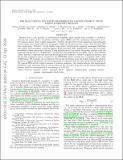Files in this item
The Sloan Digital Sky Survey Reverberation Mapping Project : the Hβ radius-luminosity relation
Item metadata
| dc.contributor.author | Alvarez, Gloria Fonseca | |
| dc.contributor.author | Trump, Jonathan R. | |
| dc.contributor.author | Homayouni, Yasaman | |
| dc.contributor.author | Grier, C. J. | |
| dc.contributor.author | Shen, Yue | |
| dc.contributor.author | Horne, Keith | |
| dc.contributor.author | Li, Jennifer I-Hsiu | |
| dc.contributor.author | Brandt, W. N. | |
| dc.contributor.author | Ho, Luis C. | |
| dc.contributor.author | Peterson, B. M. | |
| dc.contributor.author | Schneider, D. P. | |
| dc.date.accessioned | 2021-08-12T23:39:56Z | |
| dc.date.available | 2021-08-12T23:39:56Z | |
| dc.date.issued | 2020-08-13 | |
| dc.identifier | 271202692 | |
| dc.identifier | 8ac7afc7-9c0f-4ef5-9db2-fc3e41e9823f | |
| dc.identifier | 85090592587 | |
| dc.identifier | 000561551900001 | |
| dc.identifier.citation | Alvarez , G F , Trump , J R , Homayouni , Y , Grier , C J , Shen , Y , Horne , K , Li , J I-H , Brandt , W N , Ho , L C , Peterson , B M & Schneider , D P 2020 , ' The Sloan Digital Sky Survey Reverberation Mapping Project : the Hβ radius-luminosity relation ' , Astrophysical Journal , vol. 899 , no. 1 , 73 . https://doi.org/10.3847/1538-4357/aba001 | en |
| dc.identifier.issn | 0004-637X | |
| dc.identifier.other | ArXiv: http://arxiv.org/abs/1910.10719v2 | |
| dc.identifier.uri | https://hdl.handle.net/10023/23774 | |
| dc.description | Funding: KH acknowledges support from STFC grant ST/R000824/1. | en |
| dc.description.abstract | Results from a few decades of reverberation mapping (RM) studies have revealed a correlation between the radius of the broad-line emitting region (BLR) and the continuum luminosity of active galactic nuclei. This "radius-luminosity" relation enables survey-scale black-hole mass estimates across cosmic time, using relatively inexpensive single-epoch spectroscopy, rather than intensive RM time monitoring. However, recent results from newer reverberation mapping campaigns challenge this widely used paradigm, reporting quasar BLR sizes that differ significantly from the previously established radius-luminosity relation. Using simulations of the radius--luminosity relation with the observational parameters of SDSS-RM, we find that this difference is not likely due to observational biases. Instead, it appears that previous RM samples were biased to a subset of quasar properties, and the broader parameter space occupied by the SDSS-RM quasar sample has a genuinely wider range of BLR sizes. We examine the correlation between the deviations from the radius-luminosity relation and several quasar parameters; the most significant correlations indicate that the deviations depend on UV/optical SED and the relative amount of ionizing radiation. Our results indicate that single-epoch black-hole mass estimates that do not account for the diversity of quasars in the radius-luminosity relation could be overestimated by an average of ~0.3 dex. | |
| dc.format.extent | 12 | |
| dc.format.extent | 1254830 | |
| dc.language.iso | eng | |
| dc.relation.ispartof | Astrophysical Journal | en |
| dc.subject | Galaxies: active | en |
| dc.subject | Galaxies: nuclei | en |
| dc.subject | Quasars: emission-lines | en |
| dc.subject | Quasars: general | en |
| dc.subject | Quasars: supermassive black holes | en |
| dc.subject | QB Astronomy | en |
| dc.subject | QC Physics | en |
| dc.subject | 3rd-DAS | en |
| dc.subject.lcc | QB | en |
| dc.subject.lcc | QC | en |
| dc.title | The Sloan Digital Sky Survey Reverberation Mapping Project : the Hβ radius-luminosity relation | en |
| dc.type | Journal article | en |
| dc.contributor.sponsor | Science & Technology Facilities Council | en |
| dc.contributor.institution | University of St Andrews. School of Physics and Astronomy | en |
| dc.contributor.institution | University of St Andrews. St Andrews Centre for Exoplanet Science | en |
| dc.identifier.doi | 10.3847/1538-4357/aba001 | |
| dc.description.status | Peer reviewed | en |
| dc.date.embargoedUntil | 2021-08-13 | |
| dc.identifier.url | http://arxiv.org/abs/1910.10719 | en |
| dc.identifier.grantnumber | ST/R00824/1 | en |
This item appears in the following Collection(s)
Items in the St Andrews Research Repository are protected by copyright, with all rights reserved, unless otherwise indicated.

